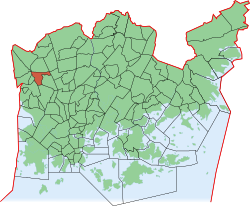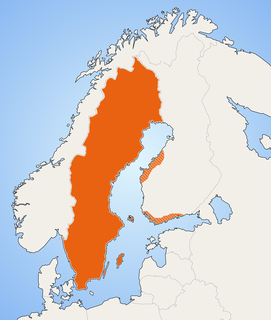
The Continuation War was a conflict fought by Finland and Nazi Germany, as co-belligerents, against the Soviet Union (USSR) from 1941 to 1944, during World War II. In Russian historiography, the war is called the Soviet–Finnish Front of the Great Patriotic War. Germany regarded its operations in the region as part of its overall war efforts on the Eastern Front and provided Finland with critical material support and military assistance.

Finland, officially the Republic of Finland, is a country in Northern Europe bordering the Baltic Sea, Gulf of Bothnia, and Gulf of Finland, between Norway to the north, Sweden to the northwest, and Russia to the east. Finland is a Nordic country and is situated in the geographical region of Fennoscandia. The capital and largest city is Helsinki. Other major cities are Espoo, Vantaa, Tampere, Oulu and Turku.
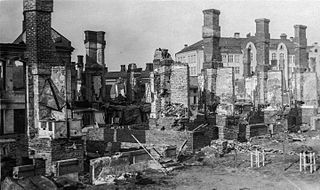
The Finnish Civil War was a conflict in 1918 for the leadership and control of Finland during the country's transition from a Grand Duchy of the Russian Empire to an independent state. The clashes took place in the context of the national, political, and social turmoil caused by World War I in Europe. The civil war was fought between the Reds, led by a section of the Social Democratic Party, and the Whites, conducted by the conservative-based Senate and the German Imperial Army. The paramilitary Red Guards, composed of industrial and agrarian workers, controlled the cities and industrial centres of southern Finland. The paramilitary White Guards, composed of farmers, along with middle-class and upper-class social strata, controlled rural central and northern Finland.
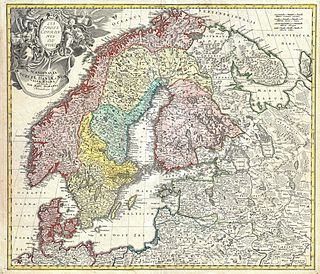
The history of Finland begins around 9,000 BC during the end of the last glacial period. Stone Age cultures were Kunda, Comb Ceramic, Corded Ware, Kiukainen, and Pöljä cultures. The Finnish Bronze Age started in approximately 1,500 BC and the Iron Age started in 500 BC and lasted until 1,300 AD. Finnish Iron Age cultures can be separated into Finnish proper, Tavastian, and Karelian cultures. The earliest written sources mentioning Finland start to appear from the 12th century onwards when the Catholic Church started to gain a foothold in Southwest Finland.
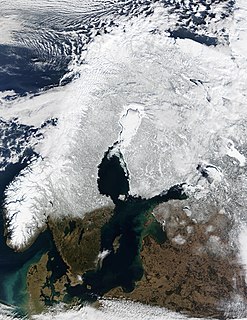
Scandinavia is a region in Northern Europe, with strong historical, cultural, and linguistic ties. The term Scandinavia in local usage covers the three kingdoms of Denmark, Norway, and Sweden. The majority national languages of these three, belong to the Scandinavian dialect continuum, and are mutually intelligible North Germanic languages. In English usage, Scandinavia also sometimes refers to the Scandinavian Peninsula, or to the broader region including Finland and Iceland, which is always known locally as the Nordic countries.

The Winter War was a military conflict between the Soviet Union (USSR) and Finland. It began with a Soviet invasion of Finland on 30 November 1939, three months after the outbreak of World War II, and ended three and a half months later with the Moscow Peace Treaty on 13 March 1940. The League of Nations deemed the attack illegal and expelled the Soviet Union from the organisation.

Espoo is the second largest city and municipality in Finland. It is part of the Finnish Capital Region, and most of its population lives in the inner urban core of the Helsinki metropolitan area, along with the cities of Helsinki, Vantaa, and Kauniainen. Espoo shares its eastern border with Helsinki and Vantaa, while enclosing Kauniainen. The city is located on the shore of the Gulf of Finland, in the region of Uusimaa and has a population of 284,444.

Turku is a city on the southwest coast of Finland at the mouth of the Aura River, in the region of Southwest Finland (Varsinais-Suomi). Turku, as a town, was settled during the 13th century and founded most likely at the end of the 13th century, making it the oldest city in Finland. It quickly became the most important city in Finland, a status it retained for hundreds of years. After Finland became part of the Russian Empire (1809) and the capital of the Grand Duchy of Finland was moved to Helsinki (1812), Turku continued to be the most populous city in Finland until the end of the 1840s, and it remains a regional capital and an important business and cultural center.

Karelia, the land of the Karelian people, is an area in Northern Europe of historical significance for Finland, Russia, and Sweden. It is currently divided among the northwestern Russian Federation and Finland.

The Grand Duchy of Finland was the predecessor state of modern Finland. It existed between 1809 and 1917 as an autonomous part of the Russian Empire.
Finns or Finnish people are a Finnic ethnic group native to Finland.
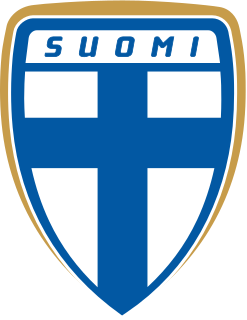
The Finland national football team represents Finland in international football competitions and is controlled by the Football Association of Finland.

Helsingin Jalkapalloklubi, commonly known as HJK Helsinki, or simply as HJK, is a professional football club based in Helsinki, Finland. The club competes in the Finnish Veikkausliiga, of which they are the reigning champions. Founded in 1907, the club has spent most of its history in the top tier of Finnish football. The club's home ground is the 10,770-seat Telia 5G -areena, where they have played since 2000.

Finland has participated in the Eurovision Song Contest 52 times since its debut in 1961. Finland won the contest for the first time in 2006 with Lordi's "Hard Rock Hallelujah". The country's best result before then was achieved by Marion Rung with the song "Tom Tom Tom" in 1973, which placed sixth.
A list of films produced in Finland ordered by year of release. For an alphabetical list of Finnish films see Category:Finnish films

The Lapland War was fought between Finland and Nazi Germany effectively from September to November 1944 in Finland's northernmost region, Lapland, during World War II. Although Finns and Germans had been fighting the Soviet Union (USSR) together since 1941 during the Continuation War, the Soviet Vyborg–Petrozavodsk Offensive in the summer of 1944 forced Finnish leadership to negotiate a separate peace agreement. The Moscow Armistice demanded Finland break diplomatic ties with Germany and expel or disarm any German soldiers remaining in Finland after 15 September 1944.
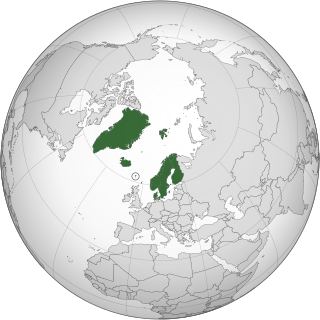
The Nordic countries or the Nordics are a geographical and cultural region in Northern Europe and the North Atlantic, where they are most commonly known as Norden. The term includes Denmark, Finland, Iceland, Norway, and Sweden, as well as Greenland and the Faroe Islands—which are both part of the Kingdom of Denmark—and the Åland Islands and Svalbard and Jan Mayen archipelagos that belong to Finland and Norway respectively, whereas the Norwegian Antarctic territories are often not considered a part of the Nordic countries, due to their geographical location. Scandinavians, who comprise over three quarters of the region's population, are the largest group, followed by Finns, who comprise the majority in Finland; other groups are indigenous minorities such as the Greenlandic Inuit and the Sami people, and recent immigrants and their descendants. The native languages Swedish, Danish, Norwegian, Icelandic, and Faroese are all North Germanic languages rooted in Old Norse. Native non-Germanic languages are Finnish, Greenlandic and several Sami languages. The main religion is Lutheran Christianity. The Nordic countries have much in common in their way of life, history, religion, their use of Scandinavian languages and social structure. The Nordic countries have a long history of political unions and other close relations, but do not form a separate entity today. The Scandinavist movement sought to unite Denmark, Norway and Sweden into one country in the 19th century, with the indepedence of Finland in the early 20th century, and Iceland in the mid 20th century, this movement expanded into the modern organised Nordic cooperation which includes the Nordic Council and the Nordic Council of Ministers. Especially in English, Scandinavia is sometimes used as a synonym for the Nordic countries, but that term more properly refers to the three monarchies of Denmark, Norway and Sweden. Geologically, the Scandinavian Peninsula comprises the mainland of Norway and Sweden as well as the northernmost part of Finland.
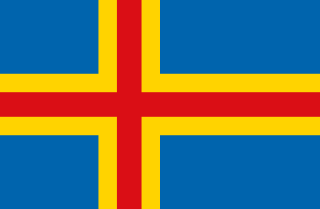
The Åland Islands or Åland is an archipelago province at the entrance to the Gulf of Bothnia in the Baltic Sea belonging to Finland. It is autonomous, demilitarised and is the only monolingually Swedish-speaking region in Finland. It is the smallest region of Finland, constituting 0.49% of its land area and 0.50% of its population.
